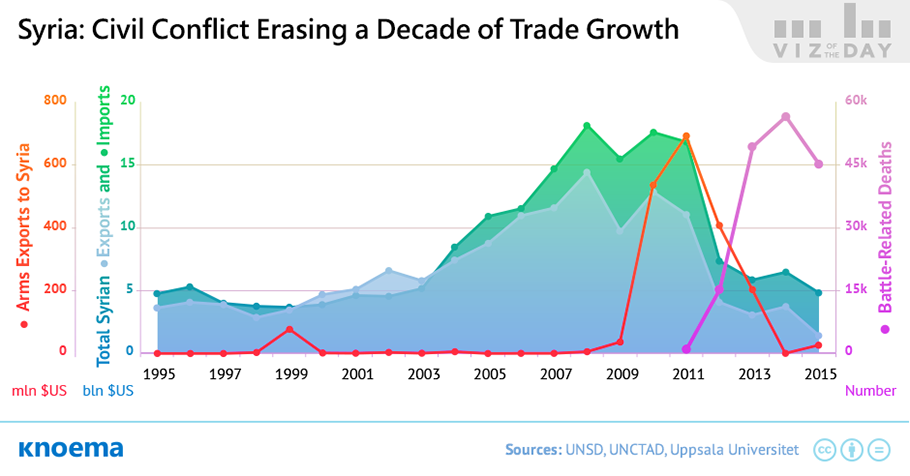An International Trade Perspective on the War in Syria
АрхивThe Syrian Civil War is the largest ongoing military conflict in the world, already claiming a total of at least 167,000 lives* since civil unrest first erupted in March 2011 on the heels of the Arab Spring. Human life is one measure of a wars devastation. Today, we examine the devastation of war from an economic perspective: international trade. The disruption in Syrian trade has already lowered its ranking globally from the 88th largest exporter in 2011 to the 141st in 2015.
- Syria experienced the world's second largest loss of total foreign trade from 2011 to 2015, with exports decreasing by 88 percent and imports by 72 percent. Greater trade losses were experienced only by Aruba, a highly import-dependent island that is economically oriented to tourism and hospitality and financial and business services.
- The decrease of foreign trade has affected virtually all commodities. There were some minor exceptions. Syrian exports of motor vehicles, fuel wood, and flat-rolled products of alloy steel grew from 2011 to 2015, however, combined these goods constituted less than 0.05 percent of the country's total exports in 2010.
- The hit to foreign trade was indiscriminate by trade partner as well. Syrian exports to 40 of its trading partners decreased by almost 100 percent (99% or more).
Humanitarian aid has partially offset some of Syria’s loss in merchandise imports. Amounting to roughly $4.5 billion in 2015, aid was almost equal to Syria's total merchandise imports that same year. These numbers should be used and considered with due caution given reporting lapses and losses that go hand-in-hand with a country in civil war.
- Trade data is not immune to reporting discrepancies, particularly when relying on one country’s exports (say exports of Russia) to estimate another country’s imports (say imports by Syria), or what is known as “mirror partner” trade statistics. According to official data from the United Nations Statistics, since 2011, Syria’s trade in the very fuel of conflict, namely arms and ammunition, has collapsed with Russia—its primary trading partner for these goods.
Learn more about Syria’s trade profile and arms and ammunition trade below in today’s Viz of the Day.
* The death toll from the Syrian Civil War varies widely among sources. Visit these sources to learn more: Uppsala Conflict Data Program, and the Syrian Revolution Martyr Database.
Материалы по теме
Foreign Trade
Constantly increasing globalization and integration of the world, often emphasized in the modern times, is carried out mostly through merchandise trade. Nowadays, wide variety of goods are involved in merchandise trade, but traditional ones, such as fuels, mining products, machinery and transport still remain most tradable. International trade of services, including transport, tourism and financial services, is also gaining momentum headed by the US as the world leader in exports and imports of services. The data on these and other indicators covering the framework of foreign trade is presented in the below datasets and visualizations. See...
Agricultural Exports and Imports
World Trade Organization provides trade statistics of exports and imports of agricultural products by country up to 2015.In 2014, the world major exporter was the US, exports of agricultural products in this country was $182,2 Billion (it was 10% of world export of agricultural products), rose by almost 128% compared with 2004. The value of the US agricultural exports grown in 2014 to $156 Billion, but leading import country of agricultural products was China, the volume of agriculture imports of China exceeded the volume of US imports by 8,4%. World Trade RankingsWorld Commodity Trade Ranking | World Services Trade Ranking Country...
